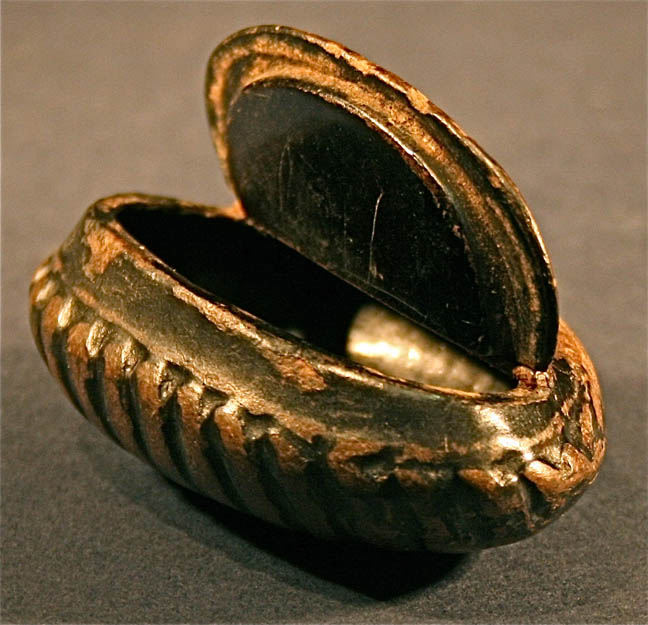

Title: Antique Black Wooden Lacquer Shall Snuff Box Vessel
Shipping: $18.00
Artist: N/A
Period: 19th Century
History: N/A
Origin: N/A
Condition: Excellent
Item Date: 1800s to 1900s
Item ID: 3492
A 19th Century Antique Box, This is a black lacquer snuff box. And an elongated hand carved black lacquer shall snuff box with a hinged lid, a decorated carved motif; interior with foil lining. Not marked. Snuff is ground or pulverized tobacco, which is generally insufflated or "snuffed" through the nose. It is a type of smokeless tobacco. There are several types, but traditionally it means Dry/European nasal snuff.
Link: http://maps.google.com/maps?client=firefox-a&hl=en&ie=UTF8&ll=35.173808,-43.242187&spn=99.052667,150
Dry snuff, or European snuff is usually scented or flavored and is intended to be sniffed through the nose. Typical flavors are floral, mentholated (also called 'medicated'), fruit, and spice, either pure or in blends.
Snufftaking by the native peoples of modern-day Haiti was observed by a monk named Ramon Pane on Columbus' second journey to the Americas during 1493-1496.
In 1561 Jean Nicot, the French ambassador in Lisbon, Portugal, sent snuff to Catherine de' Medici to treat her son's persistent migraines. Her belief in its curative properties helped to popularize snuff among the elite.
By the 1600s some started to object to snuff being taken. Pope Urban VIII threatened to excommunicate snufftakers, and in Russia in 1643, Tsar Michael set the punishment of removal of the nose for snuff use. However, elsewhere use persisted; King Louis XIII of France was a devout snufftaker, and by 1638, snuff use had been reported to be spreading in China.
By the 1700s, snuff had become the tobacco product of choice among the elite, prominent users including Napoleon, King George III's wife Queen Charlotte, and Pope Benedict XIII. The taking of snuff helped to distinguish the elite members of society from the common populace, which generally smoked its tobacco. It is also during the 1700s that the first tobacco warnings were published, among these, John Hill, an English doctor warned of the overuse of snuff, causing vulnerability to nasal cancers. Snuff's image as an aristocratic luxury attracted the first U.S. federal tax on tobacco, created in 1794.
In Eighteenth-Century Britain, the Gentlewoman's Magazine advised readers with ailing sight to use the correct type of Portuguese snuff, "whereby many eminent people had cured themselves so that they could read without spectacles after having used them for many years."
In certain areas of Africa, snuff reached native Africans before white Europeans did. A fictional representation of this is in Chinua Achebe's novel Things Fall Apart, where the Igbo villagers are regular snuff-takers long before they ever encounter the first British missionaries. In some African countries, such as South Africa and Nigeria, snuff is still popular with the older generation, though its use is slowly declining, with cigarette smoking becoming the dominant form of tobacco use.